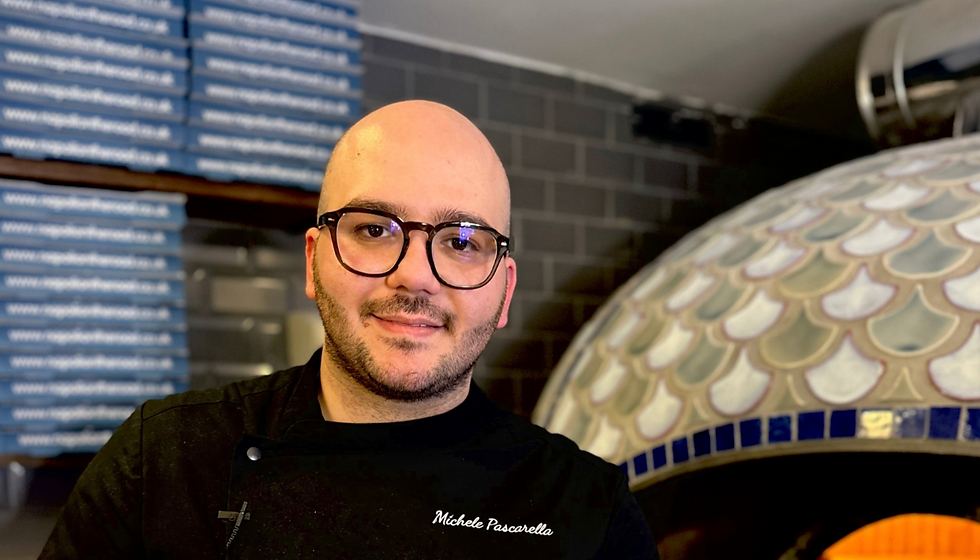Daisuke Shimoyama Discusses His New Japanese Restaurant, Kokin
- Nea Arentzen
- Jul 21
- 4 min read
For him, success signifies that customers, suppliers, staff, and he himself may all authentically experience happiness. Indeed, such enjoyment frequently necessitates difference; obstacles and adversity render the experience of fulfillment and delight genuinely significant.

Chef Daisuke Shimoyama, hailing from Gunma, possesses over 20 years of expertise in the mastery of Japanese cuisine. He perfected his skills at Tokyo’s three-Michelin-starred Nihonryori Ryugin before relocating to London to head the kitchen at Umu, ultimately establishing his own restaurant, Hannah, on the Southbank. He has returned with a new endeavor, Kokin, situated in The Stratford hotel, featuring his hallmark ingredient-centric culinary style through a wood-fired omakase menu.
The word Kokin embodies a sense of timelessness, translating from Japanese as 'past and present.' In what manner is this concept manifested within the restaurant?
In traditional Japanese cuisine, charcoal is the standard, while wood is seldom utilized. I have always harbored a profound curiosity for wood fire, a substance transmitted through centuries, imbued with warmth, strength, and distinctiveness. I aimed to investigate how wood fire may introduce a novel aspect to contemporary Japanese cuisine, providing patrons with an experience that is both elemental and sophisticated. I am both influenced by my Japanese heritage and my current identity. I appreciate the dynamic essence of the present moment and strive to embody that seasonality and personal growth in each dish I prepare.
Do you possess a signature dish?
Our hallmark dish is Tuna Kama, the collar of the tuna, which is slow-roasted for three hours over a mixture of hardwoods. Although a convection oven could do the task in about 20 minutes, we opted for the prolonged method. At that moment, smoke and focus reveal a profound and unadulterated flavor that cannot be expedited. It is a commemoration of moderation, perseverance, and the subtle fervor that only fire can evoke.

Discuss the importance of the architecture and the interior design.
The architecture and interiors of Kokin encapsulate the essence of its name. The integration of natural elements such as wood, stone, and earth with sophisticated, contemporary design fosters a serene balance between history and innovation. It is a locale where simplicity and sophistication harmoniously coexist, encouraging guests to encounter a sense of enduring opulence through the ambiance.
In what ways did your upbringing in the highlands of Gunma influence your culinary practices?
Raised in the mountainous region of Gunma, I was immersed in nature from a young age. I was repeatedly exposed to seasonal products and discovered that the flavor of the same vegetable could vary significantly based on its harvest time, necessitating an alternative cooking approach. This attention to timing and appreciation for seasonality has persisted and continues to influence my culinary style today.
How does being influenced by fire and seasonality, along with a profound regard for each food, serve as a cornerstone of your culinary philosophy?
I consider wood to be a really intriguing substance. As it combusts, the nature of the smoke transforms. Initially, the smoke exhibits a nuanced acidity that progressively transitions to more robust, rounded fragrances, ultimately culminating in a nearly smokeless phase. The smoke inherently enhances the flavor of the dish. Each wood type imparts a unique aroma, and by amalgamating various woods, we may produce layered, synergistic effects that enhance the dish's depth and complexity.
Kokin is the inaugural restaurant to offer customers the opportunity to sample temae sushi, featuring wood fire-smoked sushi rice adorned with the best wild tuna. Please tell us some additional information.
This dish originated from the discovery of a distinctive synergy between the nuanced acidity of wood smoke and the rich flavor of the red vinegar utilized in our sushi rice. By subtly smoking the rice over a wood fire, we can impart layers of aroma and complexity without overpowering the delicacy of the sushi. Guests are asked to roll the temae sushi themselves, allowing them to savor it at its peak freshness and to connect with the experience in a lively, intimate manner. Each piece is crafted with nuanced variances, providing a distinct flavor in every mouthful. The wild tuna we utilize is procured from Portugal by Mr. Tanaka, a fisherman in whom I have profound trust due to his remarkable discernment and dedication to quality. Kokin is privileged to possess exclusive rights to serve his exceptional tuna collar (kama).
What are the notable items on your menu?
At Kokin, our menu is ever evolving. Since our establishment, we have been dry-aging our Miyazaki Wagyu and tuna, and as their umami intensifies, we modify our preparation and presentation of each dish. Although a dish may appear same on the plate, the underlying technique may have evolved to enhance its optimal characteristics. Consequently, the optimal suggestion is invariably today's menu, as it embodies our most recent insights, flavors, and enhancements.
Which types of wood and charcoal do you utilize?
We utilize approximately five varieties of wood, including silver birch, cherry, and whiskey barrel oak, each chosen for its own aroma and combustion properties. These are amalgamated with charcoal to regulate the fire's strength, enabling us to differentiate between ingredients requiring rapid, high-temperature cooking and those that are enhanced by a gradual roasting process. For more delicate materials, we augment the charcoal ratio to elevate the temperature while mitigating the wood's smokiness. In our kitchen, fire serves not merely as a tool, but as an essential flavoring.
What activities do you enjoy while not in the kitchen?
I enjoy immersing myself in nature; traversing the mountains or remaining still to perceive the transition of the seasons facilitates my rejuvenation. I take pleasure in perusing vintage recipes and examining pottery, both of which frequently ignite fresh inspiration. Photography is an additional love of mine. I find it intriguing how the camera presents a perspective distinct from our visual perception. These tranquil intervals away from the kitchen facilitate my self-reconnection and enable me to approach cooking with enhanced clarity and focus.
Which cookbook do you like and what is the reason for your preference?
I frequently revisit various cookbooks. The culinary creations of Chef Yamamoto from Ryugin, Mr. Otomatsu Nishi, and Mr. Koyama from Aoyagi consistently provide novel ideas and perspectives. Their technical proficiency and philosophical insights consistently provoke me, facilitating introspection into my own methodology and identifying opportunities for development. These books provide as a perpetual source of inspiration and personal development.





Comments